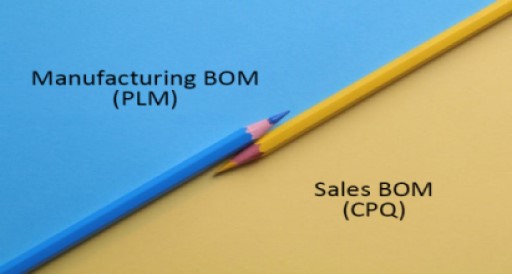The key differences between Manufacturing BOM (PLM) and Sales BOM (CPQ)
The world of products revolves around the bill of materials or product structure. It is a list of the raw materials, sub-assemblies, intermediate assemblies, sub-components, parts and the quantities of each needed to manufacture an end product.
BOMs are an integral part of the manufacturing, marketing, and sales processes. These include manufacturing and Sales bills of material. There are vast differences between manufacturing BOM and Sales BOM in their structure, process, source systems. These differences are based on the industry.
PLM’s system and Product Life Cycle
1. In PLM (Product Lifecycle Management), we track the lifecycle of the product including its engineering design, manufacturing, complete product list and relate the product back to its bill of material.
2. Autodesk Vault, Oracle Agile PLM, SAP PLM, Siemens Team center are a few of the leading PLM tools in the market which help companies to implement different modules of the PLM product like Product design (CAx), Manufacturing Process Management (MPM), Product Data Management (PDM) and Product Portfolio Management (PPM).
3. PLM tool strategy is to reduce the production cost, ensure demand is met, extend the duration of the profitability and maximize profitability as product sales decline.
4. In major tools, the product model number is an extract of the material master structure. It helps the manufacturer to track the product based on the model number.
- Example: The Marketing name of the latest iPhone is iPhone XS and the Manufacturing model name is A1920, A2097, A2098 (Japan) and A2100 (China mainland). This identification is quite different from the Marketing name for iPhone.
CPQ’s system and Product Life Cycle
1. In Configure Price and Quote, we create a product catalog, configure bundles, options, standalone products and track their versions. The actual CPQ bill of material is a reflection of what the Marketing team wants to market and sell. However, it’s important to understand that we cannot trace it back to the manufacturing BOM line by line.
2. Salesforce CPQ, Apttus CPQ, SAP CPQ, and Oracle CPQ cloud are a few of the leading CPQ tools in the market which help companies set up their products and pricing strategy, approval process, promotions and track back their renewal lifecycle
3. CPQ tool strategy is to create the product catalog, define the pricing strategy and work on approvals to reduce discount leakage and setup quote templates for the quote output.
4. The output of the CPQ systems are the product bundles and standalone part names which are specified by the Marketing team. They are easy for the sales team to relate to and sell to the customer as more often than not, the customer remembers the same name.
- Example: The Marketing part name for the latest iPhone is iPhone XS, the Manufacturing Model Names are A1920, A2097, A2098 (Japan), A2100 (China mainland), the model names are based on the country.
Integrating between PLM and CPQ tools: Recommendations
1. As part of the organizational Master Data Management(MDM), we recommend integrating the master product data from PLM with CPQ systems as part of your Quote to Cash strategy.
2. The PLM system is the source of truth for your product data. There may be an additional need to create temporary parts and attributes in the CPQ system which live and exist only in CPQ to create and sell the same product in multiple dimensions.
3. The PLM system can manage the introduction of new products and the revision of existing products. In the downstream CPQ system, the necessary configuration should be updated based on the changes in the upstream PLM system.
4. The product and its lifecycle live in the PLM system and product pricing and discount strategy live in the CPQ system
What are some of your other recommendations regarding product data for Quote to Cash implementations? Tell us
Article By Ravindra Babu Nallam — Director , Cloud Solutions — Forsys Inc

